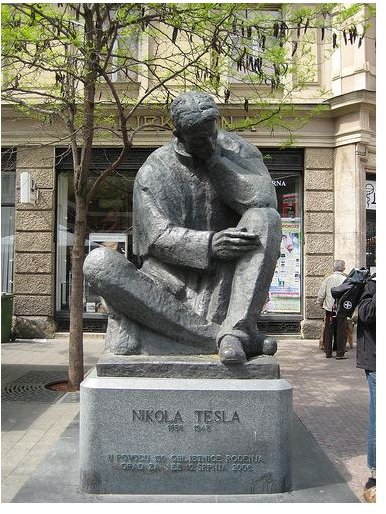Tesla Turbine Design and the Theory of Operation of an Industrial Tesla Turbine
The Tesla turbine is one of the great unknown creations of Nikola Tesla, the famed inventor of the early 20th century. Though many of Tesla’s other inventions, like the alternating current induction motor and power transmission systems, remain prominent in society, the Tesla turbine has languished in obscurity for nearly a century. The Tesla turbine design was one that really was far ahead of its time, outstripping the available materials’ capabilities as it did.
Tesla’s turbine goes by several names: boundary layer turbine, Prandtl Layer turbine, bladeless turbine, and cohesion-type turbine. These names help reveal the most unique aspect of the Tesla turbine, which is its lack of blades. Most turbines use a system of blades, which spin from the force of a fluid flowing over the blades. The Tesla turbine design relies instead on the boundary layer effect and adhesion to spin flat plates. This has a number of benefits, which will be explained further later on in the article.
Image: Flickr- PhilipShannon - Nikola Tesla
Tesla Turbine Design

The turbine consists of a number of flat discs with ventilation holes around the center, each mounted on the same shaft. Spacers placed between the discs keep them properly separated. For maximal efficiency, the spacing must be as small as possible- only 0.4 mm for a steam-propelled turbine. The discs must be very smooth, and increased smoothness is always better for proper boundary layer development. The discs are housed in a chamber, which is designed with nozzles to feed gas into the chamber. The nozzles feed in gases at supersonic speed, which is achieved by combustion outside of the chamber.
Image: Wikimedia - Tesla Turbine Schematic
Tesla Turbine Theory
As mentioned early, the Tesla Turbine uses adhesion and the boundary layer principle to derive energy from a fluid stream. Supersonic gases are directed against the chamber by several nozzles. The nozzles inject the gases at the edge of the discs, in the direction of the desired rotation. Because of boundary layer effects and the viscosity effects, the gases drag against the plates and transfer their kinetic energy to the plates, which rotate. As the gases slow, the move into the central ventilation holes and are expelled as exhaust.
Interestingly, the turbine can be altered to act as a pump instead of a turbine. In the Tesla pump design, a motor spins the discs, which then suck in fluid through the exhaust holes. This pump is useful for applications with excessively viscous, abrasive, solid-containing, or shear-averse fluids due to its increased sturdiness.
Calculations show that the turbine efficiency for Tesla turbines is above 60 percent, and up to 95 percent. Tesla himself believed that steam-powered Tesla turbines could achieve turbine efficiencies up to 95 percent. These calculations use the shear stress induced by the boundary layer effects of the flowing fluid. This requires calculation of some characteristics of the motive fluid, like the Reynolds number. To prevent drag on the ends of the discs, which reduces efficiency, the spinning plates must be as thin as possible. This requirement contributed to material problems that prevented the Tesla turbine from gaining acceptance.
Problems with the Tesla Turbine
Ironically, Tesla designed his turbine to avoid material problems faced by turbines of his day. When he designed the Tesla turbine in 1908, turbines were inefficient because of poor aerodynamic understanding and lack of materials. To maximize turbine efficiency, it is necessary for the turbine to operate at high temperatures; this is because Carnot efficiency relies on temperature differences and it is easier to heat a fluid than to cool it. However, early steels could not withstand high temperatures, limiting turbine power. Tesla sidestepped this problem by using shear drag forces and devising a system that was very efficient at relatively low speeds. However, steels of the day were not sufficiently resilient to withstand large shear forces when designed at the thickness required by the Tesla turbine design. This led to unavoidable warping when the turbines were used, and is the reason why the turbines never gained widespread use.
Industrial Tesla Turbine
Tesla turbines do not yet have large industrial usage. Tesla pumps, which are essentially the same design, are actually widely used. A design was patented in 1982, and is actually fairly common today.
There are several advantages of the Tesla turbine that may make it the turbine of the future. Because the turbine does not have projections, but instead discs, it is very stable even at high rpms. It has fewer moving parts than typical turbines: only the shaft moves. The largest Tesla model is a 5000 hp model, while the fastest operates at around 125,000 rpm. These are simply display models. With today’s better materials knowledge, Tesla turbines could be designed to operate at very high speeds for long periods of time. An industrial Tesla turbine could also be designed to feed the exhaust gases back into the intake, or to run off of hot industrial gases/fluids. Many amateur machinists have designed working models of Tesla turbines, and it is only a matter of time until commercial applications gain in prominence. Future uses may include geothermal power, where a high degree of solids is typical, and hybrid automobiles.
Sources
https://www.seabirdadventure.com/tesla_turbine
https://www.teslauniverse.com/nikola-tesla-books-bladeless-tesla-turbine-by-jeffery-a-hayes
